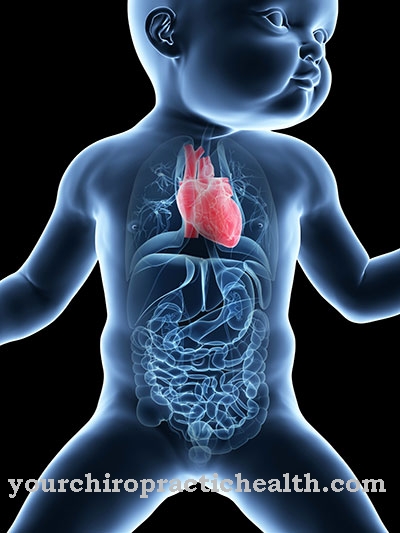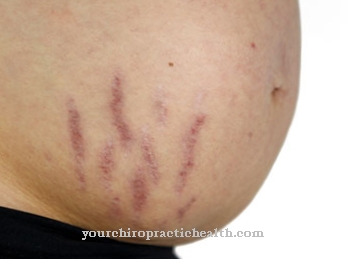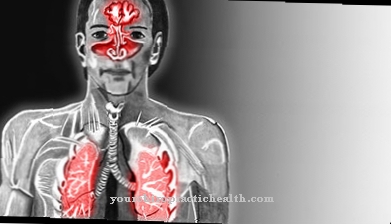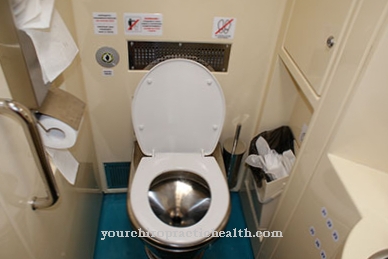A Diverticulitis is caused by infection of sacs in the intestinal wall. Diverticulitis must be treated as quickly as possible, otherwise it can lead to life-threatening complications.
What is Diverticulitis?

Diverticulitis is the inflammation of protuberances (diverticula) in the lining of the intestine. These diverticula are mainly found in the large intestine, but less often in the small intestine. A distinction is made between real and false diverticula.
With real diverticula, the entire muscle layer of the intestinal wall turns outward, with false diverticula the protrusion consists of mucous membrane tissue that pushes through a hole in the intestinal wall.
The sac-shaped diverticula usually arise from weak connective tissue, but they can also be congenital. Diverticula are common and often without symptoms. If many of these protuberances develop, one speaks of diverticulosis. Only when the diverticula become inflamed does diverticulitis exist and symptoms arise.
causes
The causes of diverticulitis are not exactly known. It is believed that a low-fiber diet initially leads to the bulges forming.
Due to the lack of fiber, the excrement becomes very hard and places a special burden on the intestinal wall. Those affected suffer from constipation. If the connective tissue becomes weaker with increasing age, the muscle layer of the intestine gives way over time and diverticula form.
As the disease progresses, diverticulitis can occur when the feces collect in the sacs and can no longer be removed from the intestines. The remnants of the feces damage the intestinal lining, it becomes inflamed and diverticulitis develops.
You can find your medication here
➔ Medicines for stomach ailments and painSymptoms, ailments & signs
In most cases, bowel diverticula do not cause symptoms or discomfort. Problems can arise if the diverticula become inflamed. Then there is primarily severe abdominal pain, which is typically localized in the left lower abdomen (in the case of the sigmoid diverticulus) or in the right middle or lower abdomen (in the case of the Meckel diverticulum or diverticulitis in the cecum).
The symptoms usually improve after a bowel movement or air leakage from the intestine. Various digestive disorders can accompany the stomach pain. Many sufferers suffer from flatulence, diarrhea or constipation, along with a strong feeling of malaise. Furthermore, pressure-sensitive induration in the abdomen can occur.
Fever and circulatory problems may also occur. If diverticulitis is left untreated, these symptoms and symptoms can develop into serious complications. This can lead to a narrowing of the intestines or even a rupture of the intestine.
If the contents of the intestine enter the stomach, peritonitis can occur, which is usually expressed as cramp-like pain and a strong feeling of illness. Untreated diverticulitis can cause bleeding into the intestines, and fistula formation between different sections of the intestine or from the intestine to a neighboring organ cannot be ruled out.
course
The first signs of diverticulitis are similar to those of appendicitis. Those affected suffer from pain in the lower abdomen, but mostly on the left side and not on the right as in appendicitis.
On the left is the sigma, a part of the intestine where diverticula are particularly common. The pain feels dull. You can often feel the hardened intestine through the abdominal wall, whereby the pressure on the intestine is painful for the patient. Constipation and flatulence occur, but diarrhea is also possible. Some people develop a fever. Sometimes there is mucus, blood, or pus in the stool.
If diverticulitis is not treated, life-threatening complications can arise. The intestinal walls can swell, abscesses (encapsulated collections of pus) and fistulas (tubular duct from an abscess) can form, and the inflammation can spread to such an extent that the intestine ruptures (perforation) and, as a result, inflammation of the peritoneum (peritonitis).
The symptoms give the doctor the first clues that diverticulitis may exist. A physical examination with palpation of the abdomen and listening to bowel sounds will provide further information. The diagnosis of diverticulitis can be confirmed with sonography (ultrasound examination), x-rays and a blood test.
A colonoscopy can provide final security, but it is not advisable in the acute state of diverticulitis, as the inflamed intestinal tissue can be easily damaged.
When should you go to the doctor?
Since this disease is a serious and life-threatening illness, a doctor should be consulted as soon as possible. In the worst case, the person affected can also die from the disease.
A doctor should be consulted if the patient suffers from pain in the abdomen and abdomen that persists for a long time and does not go away on its own. Diarrhea and constipation can also indicate the disease and should be checked if they are not related to an infection or certain eating habits.
Furthermore, the doctor must be consulted immediately if blood is evident in the stool. The emergency doctor can also be called or the hospital visited if the person concerned is unable to travel due to the pain. Flatulence can also indicate the disease. In acute emergencies, an emergency doctor should always be consulted directly. The diagnosis and treatment of the disease can, however, also be made by a gastroenterologist. As a rule, this disease has a positive course.
Doctors & therapists in your area
Treatment & Therapy
Diverticulitis must be treated immediately to avoid complications. If there is only a slight inflammation, a temporary switch to liquid food can help. The intestine is relieved and the mucous membranes can calm down. In addition, antibiotics are given to counteract the inflammation.
If there is a severe form of diverticulitis, food must be completely avoided and the patient switched to intravenous liquid food. Antibiotics are also administered to the body in higher doses by means of an infusion. After a few days, the patient can gradually switch back to solid foods. If abscesses have formed, they must be opened and drained. This procedure takes place through the skin using a tube.
If the diverticulitis has progressed so far that there is a risk of an intestinal rupture, an operation is necessary. In a surgical procedure, the part of the intestine in which the inflamed diverticula are located is removed. Sometimes an artificial anus is necessary after this operation, but this can usually be removed after the diverticulitis has healed.
Outlook & forecast
Diverticulitis must be treated by a doctor in any case, as it can otherwise lead to serious complications and even death of the person concerned. If the disease is not treated, those affected will suffer from severe pain in the stomach and abdomen. This also leads to diarrhea and constipation and, as the disease progresses, a high fever and bloody stool.
There can also be inflammation in the appendix or even in the peritoneum, although surgery is always necessary to treat this inflammation. The affected person is significantly restricted in his everyday life by diverticulitis and also suffers from a reduced quality of life.
In most cases, diverticulitis can be treated well with diet and antibiotic use. However, examinations are also necessary after treatment, as abscesses may have formed.
These then have to be surgically removed. If the removal does not happen, it can also lead to an intestinal perforation. In some cases, those affected are dependent on an artificial anus. As a rule, the life expectancy of those affected does not decrease if diverticulitis is detected and treated early.
You can find your medication here
➔ Medicines for stomach ailments and painprevention
Diverticulitis can be prevented by eating a high-fiber, healthy diet. A fiber-rich diet softens the stool, prevents constipation, and reduces the risk of developing diverticulitis.
You can do that yourself
So-called diverticula, protrusions of the intestinal mucosa or the entire intestinal wall in the descending branch of the large intestine, often occur. If the protuberances become inflamed because of the long retention time of the intestinal contents in the diverticula, it is a case of diverticulitis. It is usually announced by pain in the left lower abdomen.
If additional symptoms such as constipation or diarrhea or gas, fever, nausea and vomiting occur in the further course, this is an acute case that should not be cured with self-help measures but requires immediate clinical treatment.
In lighter cases and for prevention, the self-help measure consists of creating a menu with light and as natural as possible food. It is also important that the easily digestible food contains a high proportion of indigestible fiber. For example, many vegetables and fruits are high in fiber and meet the criteria for a healthy diet. The dietary fiber stimulates the intestinal peristalsis and leads to a shorter retention time of the food pulp in the intestine, so that the risk of inflammation in the diverticula is reduced.
If acute diverticulitis is not treated, serious complications can occur, including a rupture of the bowel, which requires immediate surgical treatment to prevent severe peritonitis.


.jpg)





















.jpg)



